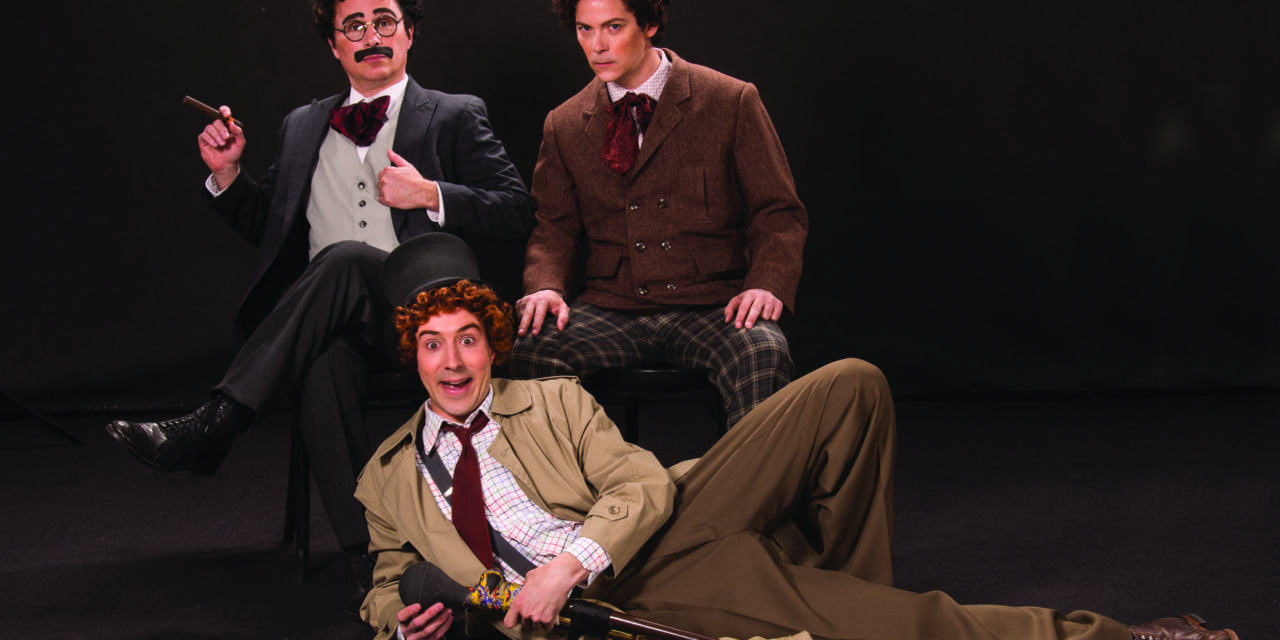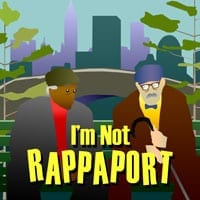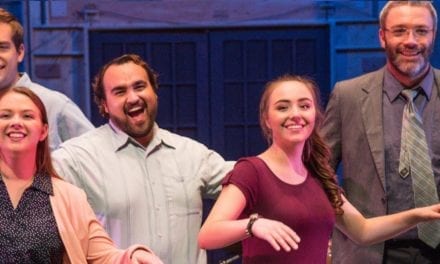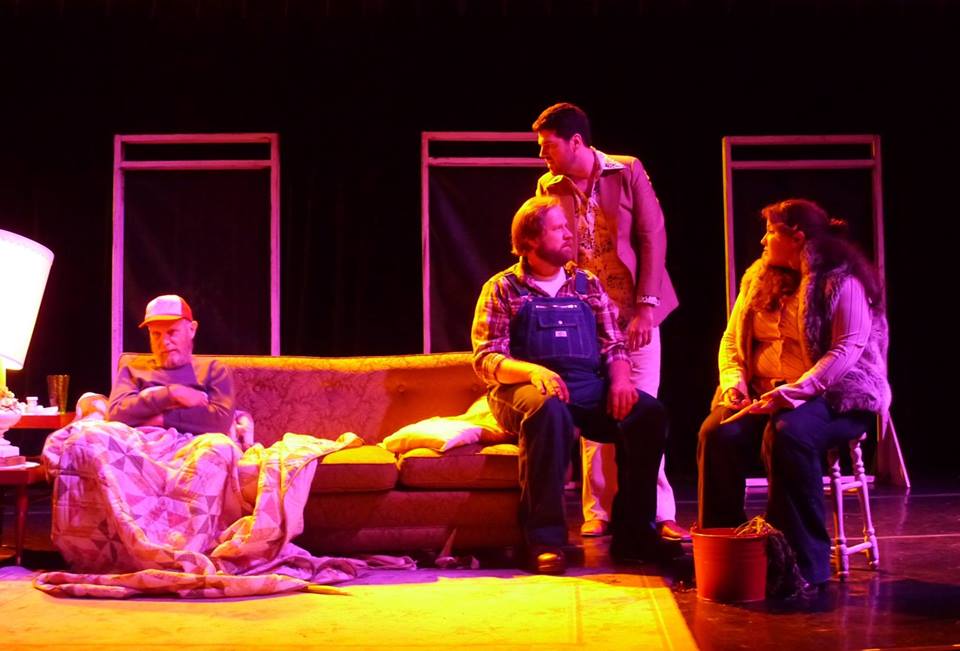CEDAR CITY — The Marx brothers—Grouch, Chico, Harpo, and Zeppo—are back. And they’re performing in The Cocoanuts, the show that made them famous nationwide.

Show closes October 15, 2016.
Taking place in the late 1920’s in Florida, The Cocoanuts tells the story of corrupt hotelier Mr. Hammer (Groucho Marx, who is played by John Plumpis) who treats his guest poorly, swindles them, and is bankrupt after some poor decisions in land speculation. His main employee is Robert Jamison (Zeppo, played by John Wascavage), a frazzled bellhop and clerk who is in love with Polly Potter (played by Anna Landy). However, Polly’s mother, the imposing Mrs. Potter (played by Kathleen M Brady), wants Polly to marry a much older man, the classy Harvey Yates (played by Michael A. Harding). But unbeknownst to Mrs. Potter, Harvey is deeply in debt and wants to use the marriage to restore his financial situation.
If the synopsis of George S. Kaufman‘s script sounds familiar, it is because The Cocoanuts has a taken from the Italian commedia del’arte tradition. Almost all the stock from commedia del’arte are there: the young lovers, the clever knave, the older intended husband, and the parent determined to arrange a marriage. The advantage of this format is that The Cocoanuts has the flexibility to allow spontaneous humor and improvization from the Marx Brothers and of the modern actors. The downside is that all the characters are flat, and the script contains a great deal of padding to fill the nearly two and a half hour running time.

John Plumpis (left) as Mr. Hammer/Groucho, Tasso Feldman as Harpo/Silent Red, and Jim Poulos as Chico/Willie Wony Diddydony. (Photo by Karl Hugh. Copyright Utah Shakespeare Festival 2016.)
The padding of The Cocoanuts takes two forms. The first is the songs by Irving Berlin (with modern musical adaptation by Gregg Coffin). Berlin’s lyrics are full of wit and sparkle, and it is easy to forgive the show for not giving the characters a solid reason to sing. Highlights from the score include “The Bell Hop” and “Five O’Clock Tea.” The other form of padding is the asides and jokes that provided a few cheap laughs. Some of these are brief puns that often elicited more moans from the audience than laughs. But others turn into long, rambling vaudevillian routines. It is the lengthy detours away from the story that makes The Cocoanuts tedious in many scenes (such as the “viaduct” sequence). However, the modern stage adapter, Mark Bedard, was forced to keep many of these routines in the script because they are so famous; cutting them would enrage fans of the film. In total, both types of padding stretch an hour-long story into a 140 or 150 minute play.
The padding in The Cocoanuts would be less noticeable if the pacing were so rapid that the time between successful jokes were short. However, director Melissa Rain Anderson’s direction allowed the actors to indulge themselves in ways that bogged the show down. One act of mugging at the audience, adding modern topical jokes, or waiting a few seconds the audience’s chuckles to die down may not hurt much. But when most leading actors are allowed to do this many times in a performance, the result is a meandering show bogged down with pacing problems. The only exception to this tendency was the probe scene, during which the actors seemed more disciplined, which permitted the comedy to come at such a rapid-fire pace that the silliness of the show was unmissable.

Tasso Feldman (top) as Harpo/Silent Red, Jim Paulos as Chico/Willie Wony Diddydony, and John Plumpis as Mr. Hammer/Groucho. (Photo by Karl Hugh. Copyright Utah Shakespeare Festival 2016.)
Now that I’ve said what was wrong with the show, it is now time to say what went right in The Cocoanuts. First and foremost is the acting. This cast knows that they’re in a corny play, but they still do all they can to sell the show and make their flat characters have some semblance of reality. Melinda Parrett took great efforts to make her character, Penelope Martin, more than just a curvy beauty. In the hands of a less caring actor, the way Penelope would scheme with Harvey could be a caricature. By making Penelope’s greed realistic, it became easier to buy into the character as an antagonist. Similarly, Landy and Wascavage provided genuine romantic chemistry between their characters (Robert and Polly), which made it easy to believe that Polly was determined to avoid an arranged marriage. This provided the paper-thin plot with some genuine emotional depth. Finally, no commendation of this cast would be complete without mentioning trio of Josh Durfey, Nicki Elledge, and Natasha Harris as the ensemble characters Nate, Trixie, and Coco. These three served as background performers in some songs and also sang during many transitions between scenes. Whether it was “Lucky Boy,” a scene transition, or the nutty dancing in “The Tale of the Shirt,” these three performers were always a delight on the stage, and I found myself looking forward to their performances.
What about the actors playing the Marx Brothers? There’s no question that they’re good. But I’m not sure that they’re good enough. The problem with these roles is that the Marx Brothers’ looks, mannerisms, and voices are so distinctive, that anything less than a perfect imitation can seem cheap and amateurish. (This is especially true of Grouch Marx, whose trademark mustache and cigar as so recognizable that people who have never seen a Marx Brothers film recognize an imitation of the legendary comedian.) Many actors can imitate a Marx brother for a few minutes, but it is supremely difficult to imitate a Marx brother for over two hours, and I don’t believe that any of the four actors pulled it off. The performances will probably be good enough for most audience members, but I doubt that aficionados of the Marx Brothers will find the performances entirely convincing.
If I could choose one word for this show, it would be “nice.” It’s nice to see an Irving Berlin musical that isn’t Annie Get Your Gun. It’s nice to see some pleasant choreography (by Natasha Harris) in songs like “A Little Bungalow” and “Lucky Boy.” And it’s nice to see a pre-Oklahoma! musical to be reminded of a simpler type of musical. But The Cocoanuts is not a relentlessly funny comedy in the vein of previous offerings at the Utah Shakespeare Festival, like Charley’s Aunt, Scapin, and Peter and the Starcatcher. Still, it’s sure bet for a nice evening at the theater.





